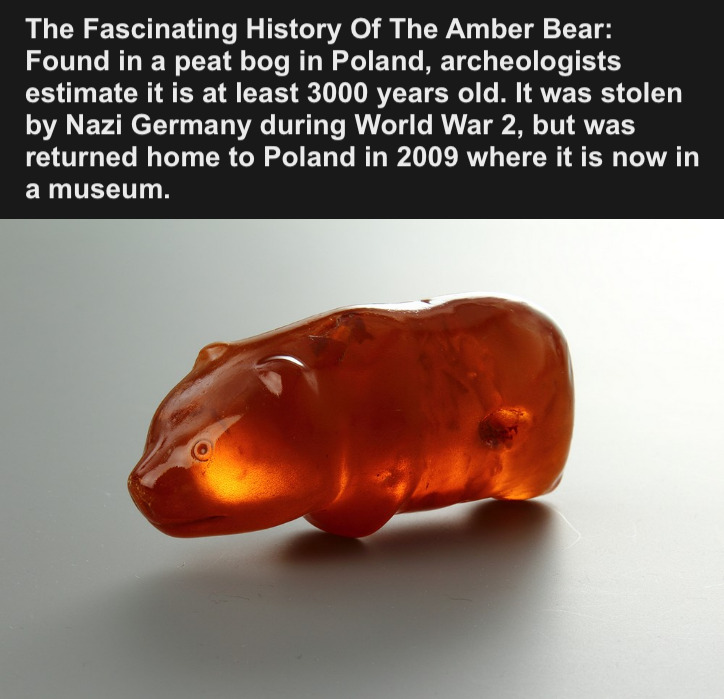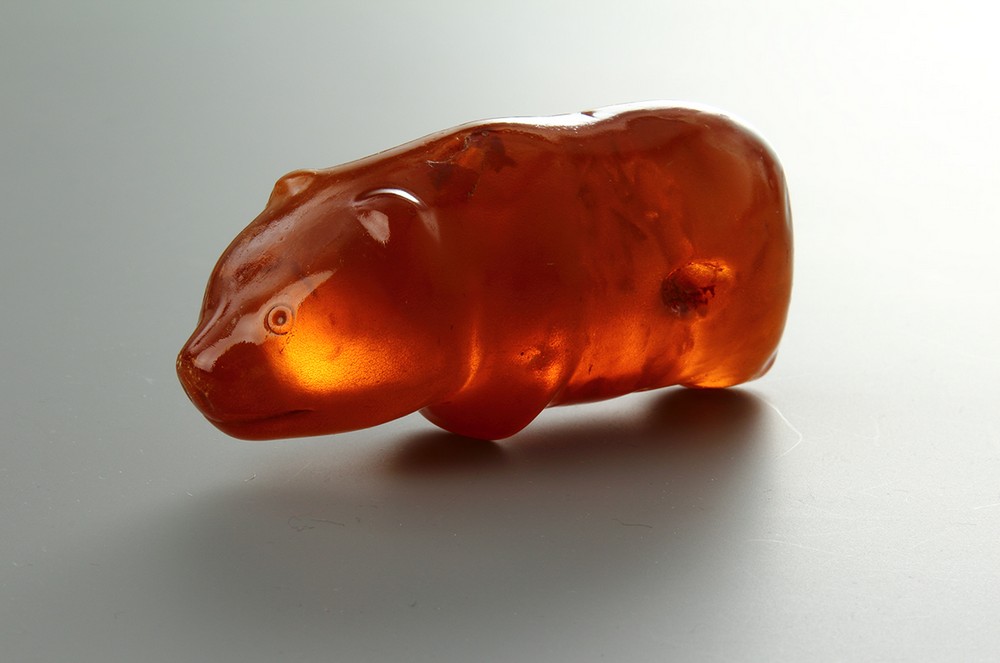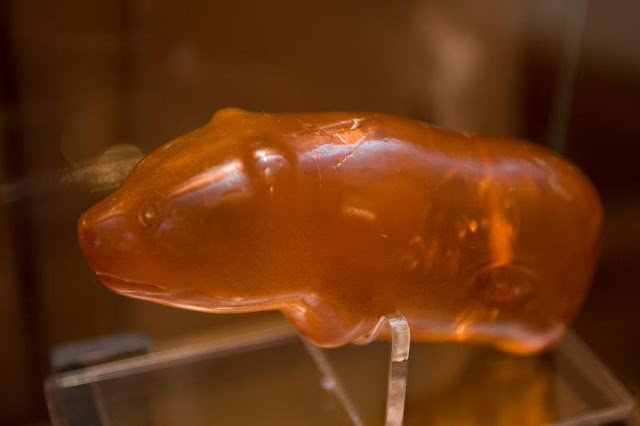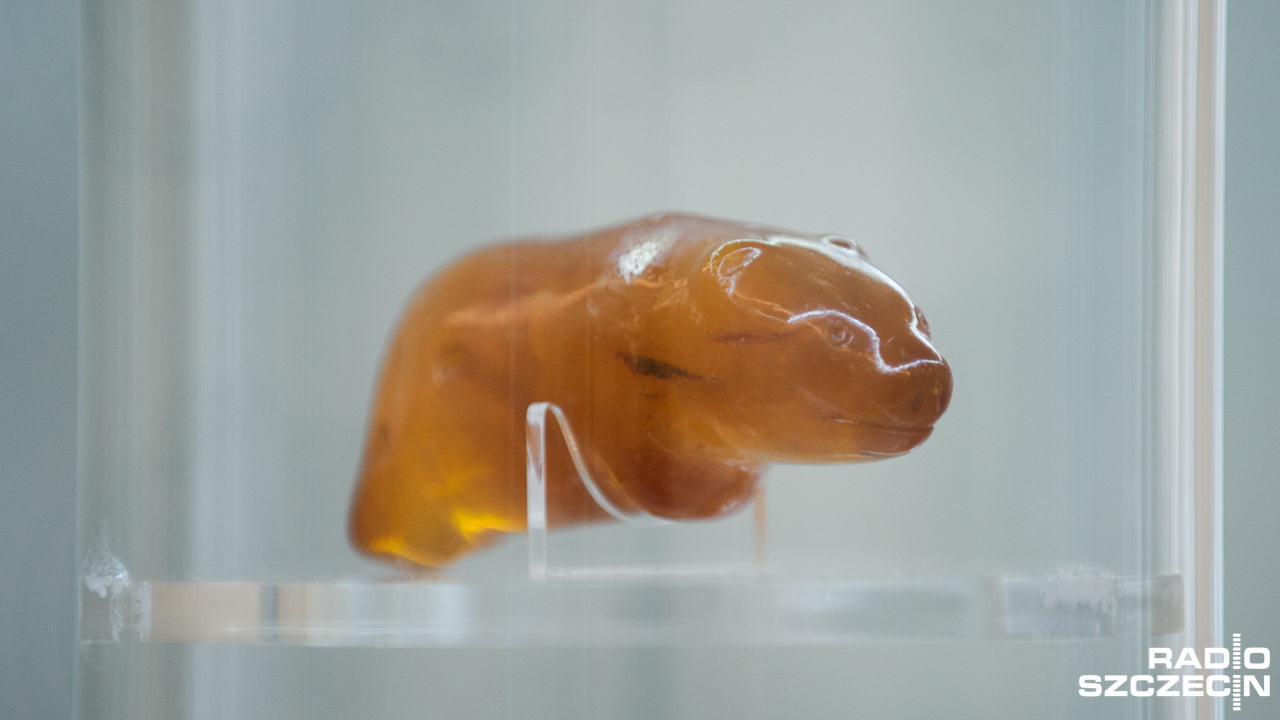
In 1887, a mysterious amber bear figure was found in a peat bog near Slupsk, Poland. The Society for Pomeranian History and Antiquities in Szczecin, Poland acquired the bear. “The bear is 10.2 cm long (4 in), 3.5 cm wide (1.4 in) and 4.2 cm tall (1.65 in). Its weight is 85 grams (3 oz).

The animal figure was created by carving and polishing a conveniently shaped piece of sea amber, which had a natural opening. The body is compact and massive… the head shows clearly modeled ears, a muzzle with a carved mouth and two nostrils as well as two circularly bordered eyes. Just before the hind legs begin, there is an aperture at the back of the figure. On the head there were remains of a dark substance, which indicate an originally partial painting of the eyes, nose and mouth.

The figure cannot stand on its own. The owner probably carried the figure on a string but if worn as a pendant, the figure hangs upside down. The importance of the bear in the belief systems of the ancient world suggests the amber bear may have had a magical function. It is not known who created the amber bear or for what purpose, but it is theorized it was created as an amulet, perhaps by a bear hunter.

The amber bear was dated between 1700 AD and 650 BC by archeologists. According to the prehistorian Thomas Terberger and Jörg Ansorge, the figure is somewhat similar to the Jutland amber bears unearthed in Denmark, which are attributed to the Maglemose culture (8500-6500 BC) in the Mesolithic period. So, while the precise date of origin is unclear, we may fairly estimate it is more than three thousand years old. (1)
The amber bear did not stay in Slupsk for long after it was discovered, as special protection was sought for the oldest artifact ever uncovered in Poland’s Pomerania region. The Amber Bear was placed in the Szczecin Museum, Poland which ensured its safety. (2)
However, Slupsk residents never were reconciled to the loss of their amber bear, and in 1924, members of the amber guild decided to create a copy. (3) Arthur Fischer was the author of the faithfully reproduced amber bear copy, and the figure became the pride of the amber collection presented in the Nowa Brama Museum in Slupsk. (4)
So for many years, the original amber bear was in the Szczecin Museum and the copy was in Slupsk. However, in 1945 just before the end of World War II, Nazi Germany stole the original Amber Bear from the museum in Szczecin, Poland and sent it to a museum in Stralsund, Germany.
That same year (1945), the amber bear copy was also stolen from the Slupsk Museum. Mysteriously, the amber bear copy resurfaced years later in the Museum of Stralsund, Germany- the same German museum where the original amber bear was being kept. (3)
Another source corroborates this story:
“The figure copy delighted the eyes of the inhabitants of Slupsk until March 1945 – when it was stolen, along with all amber and gold jewelry. Thanks to an unknown stroke of fate, the copy encountered the original, after many years, in the Historic Museum in Stralsund.” (4)
Wadysaw Filipowiak, the director of the National Museum in Szczecin, began efforts in 1972 to have the entire stolen art collection, including the original amber bear, returned to the Szczecin museum. His efforts were rewarded when, in 2009, the original artifact was returned to Poland as part of a deal between the Polish and German governments. (2)
I have not been able to verify what happened to the amber bear copy (and any information I have on it at all came from sources 3 and 4; all official source links are expired).
However, the original Amber Bear still resides today in the National Museum in Szczecin, Poland.
In recent decades, the town of Slupsk (where the Amber Bear was originally discovered) has developed a new tradition to honor their beloved bear. Every year the town commissions an amber master to create a new copy of the bear, the town then auctions the copy, and donates the resulting funds to charity. Thus, the amber bear continues to bring happiness to the citizens of Slupsk. (2)
Sources
- Thomas Terberger, Jörg Ansorge: Der Bernsteinbär von Stolp (Słupsk, Polen) – ein mesolithisches Amulett? In: Archäologisches Korrespondenzblatt 30, 2000, S. 335–352.
- Here is the Amber Bear’s page on the official website of the National Museum in Szczecin, Poland where the Amber Bear permanently resides: https://muzeum.szczecin.pl/en/collections/archaeology/stone-age.html